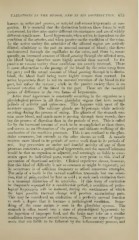Page 665 - My FlipBook
P. 665
VABTATIONS IN THE BLOOD, AND IN ITS DISTRIBUTION. 675
known as actice and passive, or arterial and venous hyper?emia or con-
gestion. It is essential that the distinction between these forms be well
understood, for they arise under different circumstances and are of widely
diiferent significance. Local hypersemia, when active, is dependent on the
condition of the arteries, and when passive on the condition of the veins.
In the active variety the arterioles of the affected region are actively
dilated, admitting to the part an unusual amount of blood ; this flows
unobstructed through the capillaries to the veins, and there is, conse-
quently, an increased amount of blood passing through the aifected area,
the blood being; therefore more highlv arterial than normal. In the
passive or venous variety these conditions are exactly reversed. There
is some obstruction to the passage of the blood by the veins aivay from
the part ; and the actual amount of blood passing through it is dimin-
ished, the blood itself being more highly venous than normal. In
active hyperceniia there is not an unusual retention of the blood in the
part, but rather the reverse ; while in the passive variety there is an
unusual retention of the blood in the part. These are the essential
points of diflerence in the two forms of hypertemia.
Active local hypercemia is constantly occurring in the organism as a
physiological process in all those glandular organs that have normal
periods of activity and (juiescence. This happens with most of the
secretory organs. The salivary glands are hypersemic while actively
secreting during the process of eating. The glands of the stomach con-
tain more blood, and much more is passing through their vessels, dur-
ing the process of digestion than in the periods of rest. This is called
for by the increased amount of work to be accomplished at these times,
and serves as an illustration of the perfect and delicate wofking of the
mechanism of the nutritive processes. Tliis is not confined to the glan-
dular structures, but extends to the other tissues as well. A muscle
receives more blood in its periods of active work than in its periods of
rest. Any perversion or undue and hurtful activity of any of these
processes constitutes a pathological hyperaemia, and the natural inference
would be that an organism so adjusted, and seemingly so liable to over-
strain upon its individual parts, would be very prone to this kind of
perversion of functional activity. Clinical experience shows, however,
that this kind of difficulty is not so common as might be expected ; yet
its occurrence is of sufficient frequency to afford numerous examples.
The pulp of a tooth in the normal condition transmits but one sensa-
tion, that of pain, excited by heat or cold ; at each such excitation there
is a transient dilatation of its arterioles. If this form of excitation
be frequently repeated for a considerable period, a condition of patho-
logical hypersemia will be induced, during the continuance of which
the least possible thermal change will produce excruciating pain.
This may be considered an exaltation of a perfectly normal function
to such a degree that it becomes a pathological condition. Some-
thing of the same nature is seen in the glandular system. The
stomach is often teased into a state of physiological hypereemia by
the ingestion of improper food, and the brain may take on a similar
condition from repeated mental excitement. These are types of hyper-
semia that are liable to be followed by the inflammatory process, and


